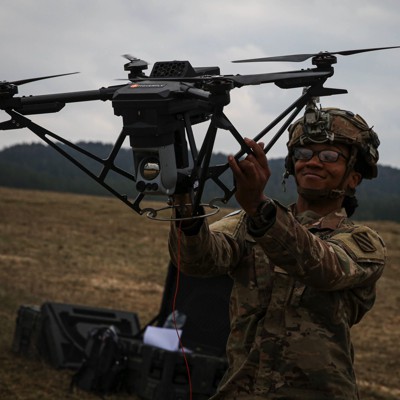The Army would gain a drone branch under proposed language in the 2025 defense authorization bill, a move intended to further professionalize the field and put it on par with the service’s other disciplines.
The Army currently fields 22 branches, from air defense artillery to transportation. The branches are the building blocks of the Army, with each job, or military occupational specialty, organized under a branch.
The change is proposed in the version of the 2025 policy bill advanced by the tactical and land forces subcommittee of the House Armed Services Committee.
In addition to drone operation, the branch would also handle counter-drone work, said a congressional staffer, speaking on background. The branch would address “not only small UASs”—unmanned aerial systems—“but also counter-small-UAS capabilities,” the staffer said.
The move is “reflective of the lessons learned in Ukraine and also reflective of what our international partners are doing,” the staffer said. Ukraine in February established a drone branch.
Designating drones as a separate branch within the Army could increase specialized training and innovation, as well as enable more targeted recruitment of drone operators, according to an op-ed published by an Army aviator.
Branches are also led by senior officers, who lead training and assist with the force modernization of their branch. The staffer said Congress had not identified a general to lead the new drone branch.
While the provision is not guaranteed to take effect, the staffer said the chances were “pretty high” it would be adopted.
The Army currently trains drone operation and counter-drone skills in a variety of locations, including the Maneuver Center of Excellence and the Joint Counter Small Unmanned Aerial Systems University. Units also conduct drone training within their own brigades.
The subcommittee’s NDAA proposal would also fund the Army’s top three requirements from its unfunded priority list, all related to counter-drone equipment, for a total of $350 million, the staffer said.
Separate language in the proposal calls for the Army to “establish and operate an Electronic Warfare Center of Excellence within the Army Training and Doctrine Command.” Electronic warfare has similarly taken on increased importance thanks to the Russian-Ukrainian war, with U.S. precision weapons frequently falling prey to Russian electronic warfare.
Read the full article here


:quality(70)/cloudfront-us-east-1.images.arcpublishing.com/archetype/QIWQFZ3MB5HWTB4AFESR55IEXE.JPG)
:quality(70)/cloudfront-us-east-1.images.arcpublishing.com/archetype/YHDGILSCVVG3LEYJGLOZSPIEEQ.JPG)
:quality(70)/cloudfront-us-east-1.images.arcpublishing.com/archetype/E43XN2JDZZAMXOSMQBU5SPU53E.jpg)

:quality(70)/cloudfront-us-east-1.images.arcpublishing.com/archetype/XASOEXOQIZBHNJPL4LU45DSLZ4.jpg)
Leave a Reply